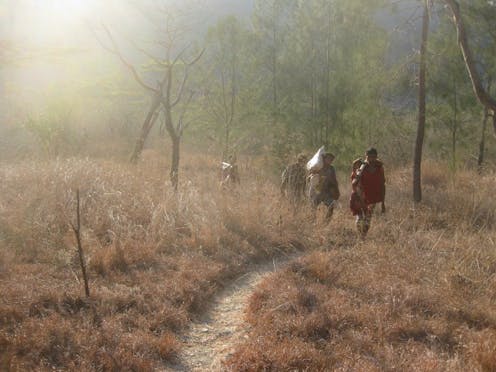in Timor-Leste’s remote Oecusse Enclave, a border dispute threatens to open old wounds
- Written by Michael Rose, Research Associate, University of Adelaide

In September, Timor-Leste will mark a quarter century since its vote for independence from Indonesia, the conclusion of a 24-year long struggle that left few Timorese families untouched.
Reconciliation with its giant neighbour stands out as one of Timor-Leste proudest achievements, but as 2024 begins, a long simmering border dispute, in which a border hamlet faces the prospect of its land being transferred to Indonesia, is stirring both political strife and ghosts many hoped were at rest.
Read more: Timor-Leste election offers an extraordinary lesson in how to build a stable democracy
Where is the land?
The area in question is a hamlet called Naktuka. It’s around 1,000 hectares of rare old-growth forest and rice fields on the western edge of Timor-Leste’s Oecusse (also spelled Oecussi) Enclave. Oecusse is 800 square kilometres of rugged coast and mountains some 70 kilometres west of the rest of Timor-Leste.
Although Naktuka is home to only around 60 families, and a four hour drive along a coastal track from the nearest major town, to the people of Oecusse it is anything but marginal. Its forests are the domain of Oecusse’s king (usif), and the place he periodically gathers the Enclave’s clans to celebrate their identity as “people of the dry land” (Atoni Pah Meto) and subjects of their legendary forebear, Lord Benu (Ama Benu). For them, Naktuka is pah le’u (sacred land).
However, in the wake of recent border negotiations between Indonesia and Timor-Leste, concerns have been raised over how much longer they will be free to access it.
At the end of 2023, Naktuka was visited by a team from the Timor-Leste’s government who oversaw the placement of around 76 metal stakes (estaka) along a line some 350 meters inland from the frontier. Suspicions quickly grew it was to be a new border.
Such a border would cede around 270 hectares of forest and rice fields to Indonesia.
Subsequent developments didn’t allay concerns. On February 1 2024, the head of the technical team working on the border said the stakes did not represent a new frontier, but were being used to assess where one might be placed.
Coupled with an announcement by the CNRT Media Centre, mouth-piece of Timor-Leste’s ruling party, that a “win-win” solution could involve dividing Naktuka in half and giving away around 500 hectares, this was cold comfort.
Read more: Cash for the winner, the loser for dinner: cockfighting in Timor Leste is a complicated game
They even posted a map from the Indonesian Geospatial Information Agency showing how it might look.
In Timor-Leste, this has resulted in an angry backlash. The signing of the border agreement, which was to have occurred in Jakarta in late January, has been postponed.
A small hamlet on a divided island
Recent questions over the ownership of Naktuka stem from unresolved negotiations over the border between Timor-Leste and Indonesia, created when the latter regained its independence in 2002.
While Naktuka is governed by Timor-Leste, in 2005, Timor-Leste signed an agreement confirming the status of around 95% of its border with Indonesia, with a small number of areas to be clarified later. Naktuka was one. The reason goes back at least 120 years.
In 1904, when the Dutch and Portuguese moved to finalise the division of Timor, they differed in their interpretation where Oecussi’s borders should be. By 1915 the question was effectively settled. The Portuguese put down milestones and proceeded to govern Naktuka for 50 years.
With the Indonesian invasion of 1975, Naktuka, along with the rest of Portuguese Timor, became part of the province of Timor Timur. In 1999 it voted in Timor-Leste’s independence referendum and was incorporated, as a former part of both Portuguese Timor and Timor Timur, into Timor-Leste.
Indonesia argues that as Naktuka should not (arguably) have become part of Portuguese Timor 110 years ago, it should not be part of Timor-Leste now. Suffice to say this is not an argument that makes such sense to the people who live there today, or many of their compatriots.
Naktuka is remote and poor. After independence its people got on with life. Their days revolved around rice farming and their role as caretakers of the land, including the king’s forest, site of the royal feast of ‘seu puah (the communal betel nut harvest). The population grew, slowly, and in many ways Naktuka was similar to any other hamlet in Timor-Leste.
And yet, periodic incidents reminded people of their limbo. In 2013, the Timor-Leste Police were prevented from building a guard-post. Indonesian soldiers would come across the frontier, often just bored, but an unpleasant reminder of the occupation. In 2012 there was even a murder which local media reported was committed by people from across the border. The Indonesian press carried the occasional article about citizens of Timor-Leste settling illegally in an area they called “disputed”, but to residents was simply home.
There’s no doubt the intentions of Timor-Leste government in seeking a permanent fix on its western border are good, but the idea it can do so by ceding land is surprisingly out of touch with reality. In Timor-Leste sovereignty is sacred, literally, as is the principle of consent and consultation on matters relating to land. Any solution to the situation in Naktuka that ignores this is very unlikely to work.
Authors: Michael Rose, Research Associate, University of Adelaide





